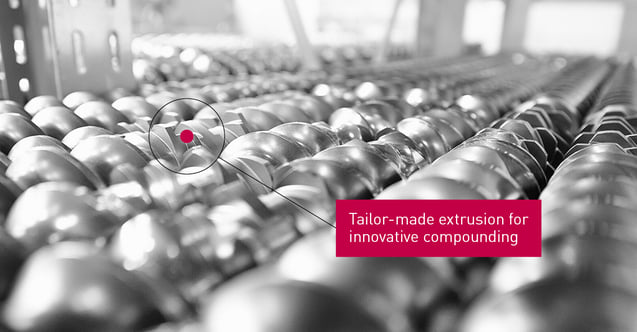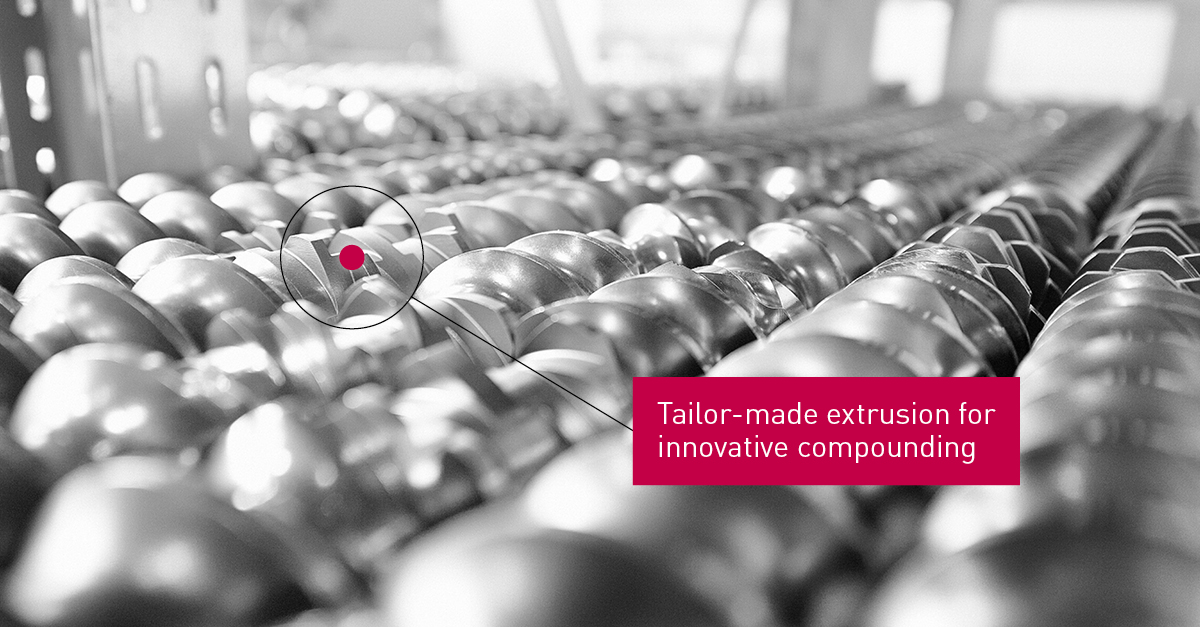Extruder and screw. The key to successful compounding.

In plastics processing, compounding technology is the central process that specifically modifies the properties of base materials/polymers in order to meet specific application requirements. It is the harmonious, precisely coordinated interplay of chemistry and physics that plays a key role in this process. By combining chemical reactions with physical principles, innovative materials with tailor-made properties are created. This blog post is about what is important in this process and why everything ultimately revolves around the extruder and its screws.
Process engineering/processing is the key element that makes it possible to combine the raw materials into a high-quality compound in a complex process. A really good compounder is characterized above all by the fact that he:- can control all its machines - above all the extruder including the peripheral systems - so precisely that it can optimally process the formulations of polymers, additives and fibers available to it, and
- influencing factors such as temperature, speed and throughput are finely balanced so that the material reaches its optimum performance after mixing, kneading, tempering and melting.
In the extruder, both each individual screw element and the sequence are important.
Compounding systems - usually twin-screw extruders - are complex machines that consist of a large number of components. The heart of the machine is the screw. It consists of various screw elements, each of which in turn fulfills specific functions. These screws can consist of up to 40 different elements. The selection and arrangement of these elements in the screw are decisive factors for the success of the manufacturing process. Each element has its own specific task, such as kneading, mixing or shearing the material.
Expertise in the arrangement of the individual screw elements is of great importance to ensure that the desired properties of the material are achieved. The correct composition and arrangement of the screw elements are crucial for the efficiency and quality of the extrusion process.
Natural laws are nothing without experience.
In addition to the incontrovertible physical and chemical laws, there is another component that is based on experience: A really good compounder simply has to know, based on his experience, how a polymer reacts in order to be able to work effectively with the extruder. This is because different polymers have different melting temperatures, viscosities and other sensitivities. Some polymers require gentle processing (as they can be easily damaged), while others require intensive shearing. Added to this is the selection and arrangement of the screw elements in the extruder: certain elements break up the material, while others ensure homogeneous distribution.
In short, the experience of the compounder is crucial to making the right decisions when configuring the screw and producing high-quality compounds.
Really important 1: Handling the dosing positions
The dosing positions on the screw are crucial for the effective mixing of the ingredients in a recipe. Depending on the type of materials and their sensitivity, they must be added at different points. Some components are placed at the beginning of the screw to ensure a longer residence time, while others, such as some additives and fibers, are dosed later in the process to avoid damage. The correct dosing position is crucial to ensure that the materials not only remain intact, but also have sufficient time to mix optimally. Experience also plays an important role here, as different combinations of dosing positions and screw set-ups must be considered to ensure a high-quality end product. Optimal mixing results can only be achieved through careful selection and precise placement of the raw materials.
Really important 2: The combination of dispersive and distributive mixing
Speaking of "optimal blending": an experienced compounder also has the ability to master both dispersive and distributive blending - and above all the combination of both. A good example of this is the handling of carbon fibers: When handling carbon fibers, it is crucial that they are not cut up, but rather that their length is retained as far as possible. The art of compounding then consists of not only mixing the fibers, but also distributing them in a targeted manner. The length of the fibers is determined and controlled by precise measurements at the start of the process. This makes it possible to design the screw accordingly to ensure that the fibers remain as long as possible at the end of the process and can therefore develop their optimum effect - the mechanical reinforcement of the polymer.
Conclusion: Successful compounding is based on the successful formula of physics+chemistry+experience
LEHVOSS Customized Polymer Materials (CPM) offer - based on more than 50 years of experience - the expertise needed to process or compound raw materials in any form - be it granulates, flakes, powders, liquids or fibers. Raw materials in the form of virgin material or recycled material. Precisely measured on the extruder in doses of 5 grams to 500 kilograms per hour. Based on a collection of recipes that has grown massively over more than five decades, as well as a range of possible combinations of screw elements that have grown in parallel - after all, each recipe has its own screw, which can be up to 4 meters long.
You are welcome to convince yourself personally of this expertise; use the LEHVOSS advantage to your advantage. Dr. Linda Trosse, Head of Process Engineering Development at Lehmann&Voss&Co. KG and Technical Managing Director of WMK Plastics GmbH, will be happy to help you with any questions and decision-making.

